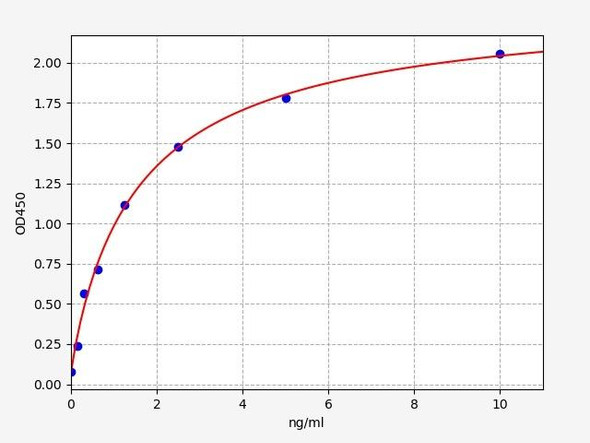Description
| Product Name: | CYP2D6 Recombinant Protein |
| Product Code: | RPPB1549 |
| Size: | 20µg |
| Target: | CYP2D6 |
| Synonyms: | Cytochrome P450 2D6, CYPIID6, P450-DB1, Debrisoquine 4-hydroxylase, CYP2D6, CPD6, CYP2D, CYP2D@, CYP2DL1, P450C2D, MGC120389, MGC120390, LKM1, liver/kidney microsomal antigen 1. |
| Source: | Sf9 Insect cells |
| Physical Appearance: | Sterile filtered liquid formulation. |
| Formulation: | LKM-1 is supplied in�17mM HEPES pH-7.5, 425mM NaCl, 1mM DTT, 1% Triton X-100 and 15% glycerol. |
| Stability: | Store at 4°C if entire vial will be used within 2-4 weeks.�Store, frozen at -20°C for longer periods of time.�Avoid multiple freeze-thaw cycles. |
| Purity: | Greater than 95% as determined by SDS-PAGE. |
Cytochrome P450 2D6 is a member of a complex family of microsomal enzymes (mono-oxygenases) present in the endoplasmic reticulum membrane, which perform detoxification reaction on xenobiotic compounds. Cytochrome P450 2D6 is the molecular target of autoantibodies against the "liver kidney microsomal antigen 1" (LKM 1) which has been classically defined by immunofluorescence microscopy. The presence of these autoantibodies is considered indicative of Autoimmune Hepatitis Type 2; LKM 1 antibodies have also been detected in patients with hepatitis C viral infection. The International Autoimmune Hepatitis Group therefore has subdivided the AIH type 2 into two subgroups: 2a with HCV and 2b without HCV. AIH 2a patients are often over 40 and predominantly male.The use of a purified recombinant Cytochrome P450 2D6 antigen allows the differentiation of autoimmune hepatitis from drug-induced hepatitis where transient autoantibodies to other P450 family members occur which cannot be differentiated by immunofluorescence techniques.
Cytochrome P450 2D6 Human Recombinant (also called liver/kidney microsomal antigen 1) produced in SF9, is a glycosylated, polypeptide chain having a molecular mass of 60 kDa. The LKM1 is purified by proprietary chromatographic techniques.
| UniProt Protein Function: | CYP2D6: Responsible for the metabolism of many drugs and environmental chemicals that it oxidizes. It is involved in the metabolism of drugs such as antiarrhythmics, adrenoceptor antagonists, and tricyclic antidepressants. Belongs to the cytochrome P450 family. |
| UniProt Protein Details: | Protein type:Oxidoreductase; EC 1.14.14.1; Xenobiotic Metabolism - drug metabolism - cytochrome P450 Chromosomal Location of Human Ortholog: 22q13.1 Cellular Component: endoplasmic reticulum; endoplasmic reticulum membrane; mitochondrion Molecular Function:arachidonic acid epoxygenase activity; drug binding; heme binding; iron ion binding; monooxygenase activity; oxidoreductase activity; steroid hydroxylase activity Biological Process: alkaloid catabolic process; alkaloid metabolic process; arachidonic acid metabolic process; coumarin metabolic process; drug catabolic process; drug metabolic process; heterocycle metabolic process; isoquinoline alkaloid metabolic process; monoterpenoid metabolic process; negative regulation of binding; steroid metabolic process; xenobiotic metabolic process Disease: Drug Metabolism, Poor, Cyp2d6-related |
| NCBI Summary: | This gene encodes a member of the cytochrome P450 superfamily of enzymes. The cytochrome P450 proteins are monooxygenases which catalyze many reactions involved in drug metabolism and synthesis of cholesterol, steroids and other lipids. This protein localizes to the endoplasmic reticulum and is known to metabolize as many as 25% of commonly prescribed drugs. Its substrates include antidepressants, antipsychotics, analgesics and antitussives, beta adrenergic blocking agents, antiarrythmics and antiemetics. The gene is highly polymorphic in the human population; certain alleles result in the poor metabolizer phenotype, characterized by a decreased ability to metabolize the enzyme's substrates. Some individuals with the poor metabolizer phenotype have no functional protein since they carry 2 null alleles whereas in other individuals the gene is absent. This gene can vary in copy number and individuals with the ultrarapid metabolizer phenotype can have 3 or more active copies of the gene. Alternatively spliced transcript variants encoding different isoforms have been found for this gene. [provided by RefSeq, Jul 2014] |
| UniProt Code: | P10635 |
| NCBI GenInfo Identifier: | 84028191 |
| NCBI Gene ID: | 1565 |
| NCBI Accession: | P10635.2 |
| UniProt Secondary Accession: | P10635,Q16752, Q2XND6, Q2XND7, Q2XNE0, Q6B012, Q6NXU8 |
| UniProt Related Accession: | P10635 |
| Molecular Weight: | 50,061 Da |
| NCBI Full Name: | Cytochrome P450 2D6 |
| NCBI Synonym Full Names: | cytochrome P450 family 2 subfamily D member 6 |
| NCBI Official Symbol: | CYP2D6�� |
| NCBI Official Synonym Symbols: | CPD6; CYP2D; CYP2DL1; CYPIID6; P450C2D; P450DB1; CYP2D7AP; CYP2D7BP; CYP2D7P2; CYP2D8P2; P450-DB1�� |
| NCBI Protein Information: | cytochrome P450 2D6 |
| UniProt Protein Name: | Cytochrome P450 2D6 |
| UniProt Synonym Protein Names: | CYPIID6; Cholesterol 25-hydroxylase |
| Protein Family: | Cytochrome |
| UniProt Gene Name: | CYP2D6�� |
| UniProt Entry Name: | CP2D6_HUMAN |










